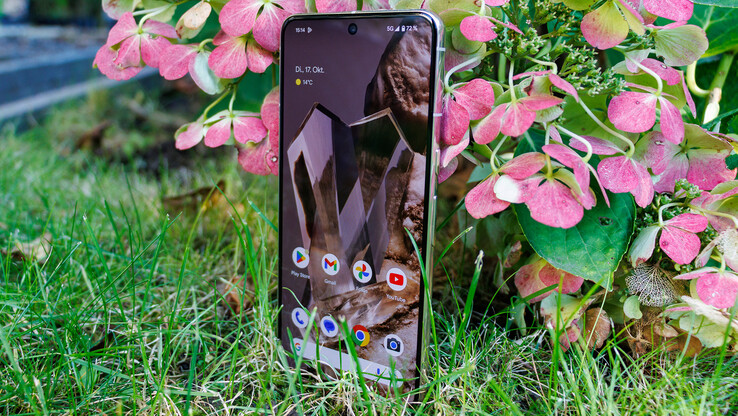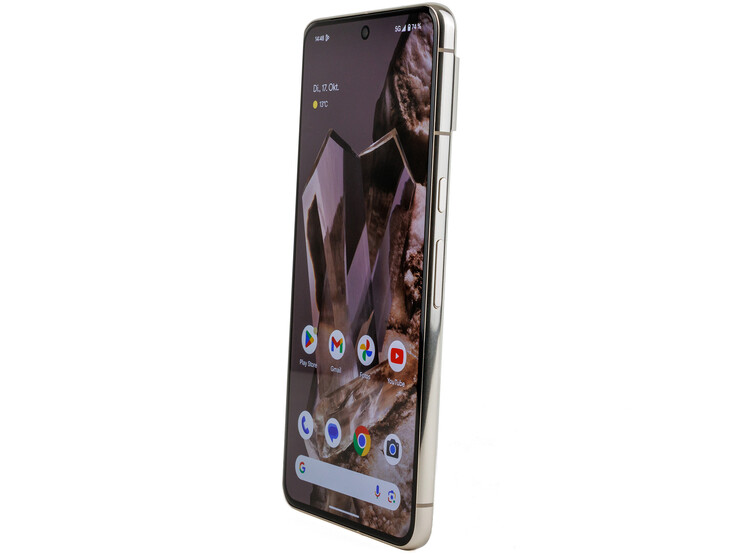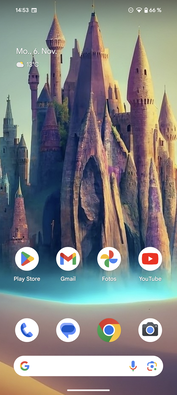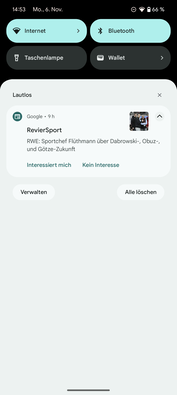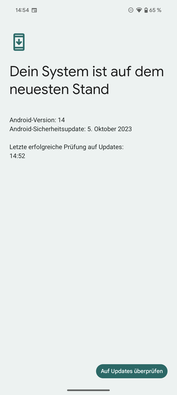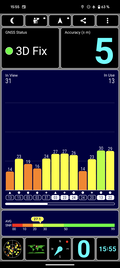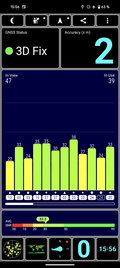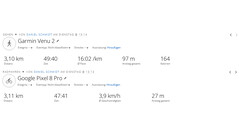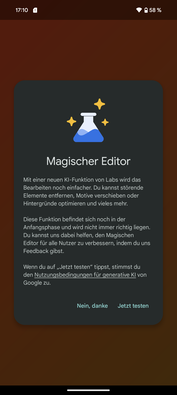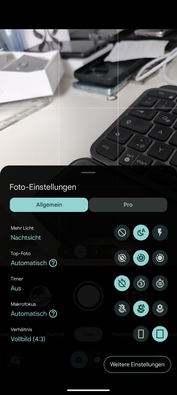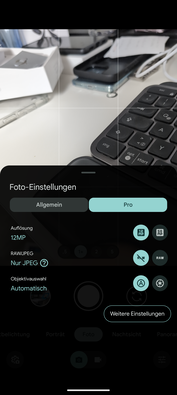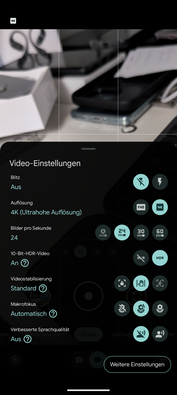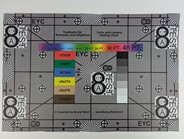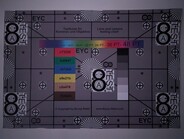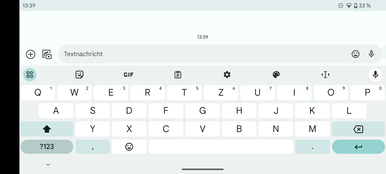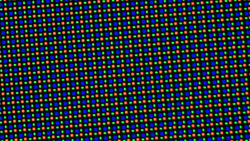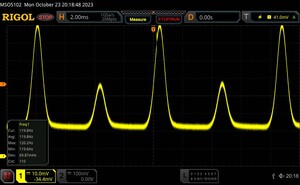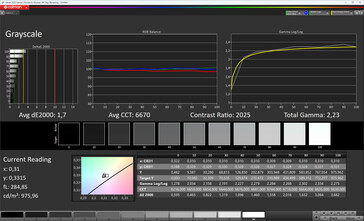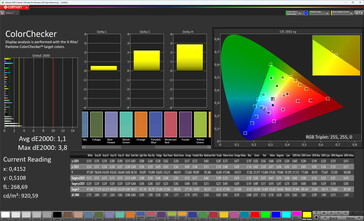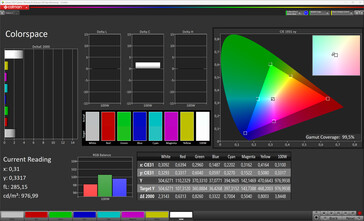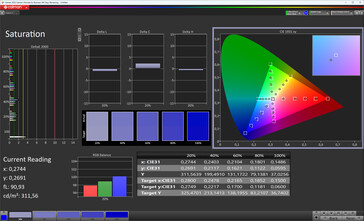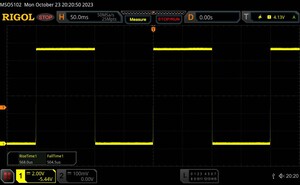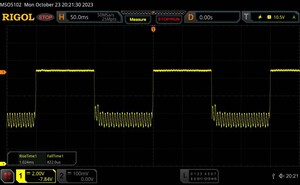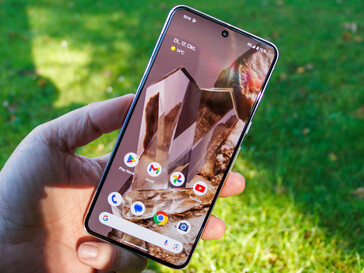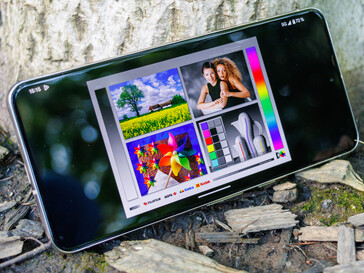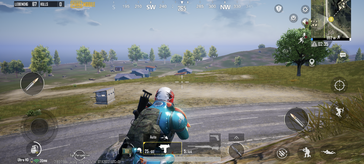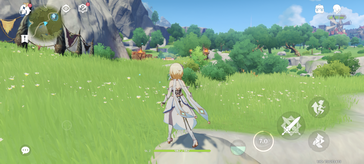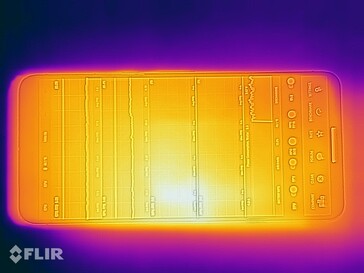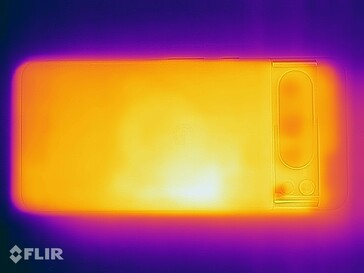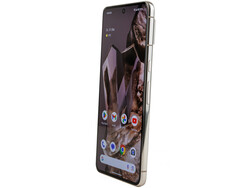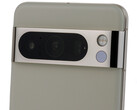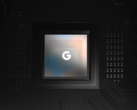Google Pixel 8 Pro review - Powerful Android smartphone with seven years of updates
The Google Pixel 8 Pro is the direct successor of the Pixel 7 Pro, with only a gentle update of the design. As the new chipset, the Tensor G3 is used, and Google made some powerful improvements in the cameras, particularly with the ultrawide angle lens, which now offers a hefty 48 MP.
The storage equipment was also improved, and the Pixel 8 Pro now offers up to 512 GB in Germany. At this point, there is even a 1-TB version available in the US for ~$1,400. Unfortunately, Google has also increased the prices significantly:
| Pixel 8 Pro | Pixel 7 Pro | Difference | |
|---|---|---|---|
| 128 GB | 1,099 Euros (~$1,175) | 899 Euros (~$962) | +200 Euros (~$214, +22.25%) |
| 256 GB | 1,159 Euros (~$1,240) | 999 Euros (~$1,068) | +160 Euros (~$171, +16.02%) |
| 512 GB | 1,299 Euros (~$1,389) | - | - |
With these prices, Google is approaching the flagships of the competitors such as the Galaxy S23 Ultra, the Honor Magic5 Pro, or the Xiaomi 13 Pro. On the other hand, the Pixel 8 Pro is also the first Android smartphone with an update guarantee of seven years. So is it a good deal after all?
Top 10 Laptops
Multimedia, Budget Multimedia, Gaming, Budget Gaming, Lightweight Gaming, Business, Budget Office, Workstation, Subnotebooks, Ultrabooks, Chromebooks
under 300 USD/Euros, under 500 USD/Euros, 1,000 USD/Euros, for University Students, Best Displays
Top 10 Smartphones
Smartphones, Phablets, ≤6-inch, Camera Smartphones
Possible Competitors in Comparison
Rating | Date | Model | Weight | Drive | Size | Resolution | Best Price |
|---|---|---|---|---|---|---|---|
| 89 % | 11/2023 | Google Pixel 8 Pro Tensor G3, Mali-G715 MP7 | 213 g | 128 GB UFS 3.1 Flash | 6.70" | 2992x1344 | |
| 88.1 % | 10/2023 | Xiaomi 13T Pro Dimensity 9200+, Immortalis-G715 MP11 | 206 g | 512 GB UFS 4.0 Flash | 6.67" | 2712x1220 | |
| 91.1 % | 10/2023 | Apple iPhone 15 Pro Max A17 Pro, A17 Pro GPU | 221 g | 256 GB NVMe | 6.70" | 2796x1290 | |
| 91.1 % | 03/2023 | Samsung Galaxy S23 Ultra SD 8 Gen 2 for Galaxy, Adreno 740 | 233 g | 256 GB UFS 4.0 Flash | 6.80" | 3080x1440 | |
| 90.1 % | 07/2023 | Honor Magic5 Pro SD 8 Gen 2, Adreno 740 | 219 g | 512 GB UFS 4.0 Flash | 6.81" | 2848x1312 |
Case - The Pixel 8 Pro is covered by matte glass
While the Google Pixel 8 Pro became slightly more compact, it now weighs 1 gram (~0.035 oz) more. Although at a thickness of 8.8 mm (~0.346 in), it is slightly slimmer than the Pixel 7 Pro with its 8.9 mm (~0.35 in), if you add the camera, the 8 Pro is thicker than its predecessor, reaching a thickness of up to 12 mm (~0.47 in).
The combination of polished aluminum and matte Corning Gorilla Glas Victus 2 on the back gives it a very elegant and high-quality appearance. With the tight and even gaps between the materials, the workmanship also leaves a clean impression. The Google smartphone endures attempts of warping it without producing any creaking noises.
The Pixel 8 Pro is dust and waterproof according to the IP68 certification. It is available in the colors "Bay" (bright blue), "Obsidian" (black), and "Porcelain" (beige), with our test unit being the latter version.
Equipment - Google smartphone with USB 3.2 and UWB
Google doesn't give any detailed specifications on the USB-3.2 port in the Pixel 8 Pro. The transfer speed of 103.73 MB/s in the copy test indicates that this might be USB 3.2 (Gen. 1), even if it is a comparably slow implementation. Wired display output is also not supported. Connected storage can be formatted either in FAT32 or exFAT.
In addition, Bluetooth 5.3, NFC, and UWB are also included. While an always-on display function is supported, it is deactivated by default.
Software - Pixel 8 series get 7 years of updates
The Pixel 8 Pro is delivered with Android 14 and will get seven years of both security patches and version updates - outstanding!
The Pixel 8 Pro also brings some innovations that are all supported by machine-learning algorithms or AI. Those include the Magic Editor, AI Wallpaper, Video Boost, and the Audio Magic Eraser. The new Night Sight video function, which will be added later, is supposed to raise videos recorded in the dark to a new level. All thanks to Google AI. But the only downside is that those functions are not implemented on the smartphone itself but computed in the cloud (we report). This also goes for GBoard proofreading, which is currently only available for the English language.
Other established functions such as the Magic Eraser or GBoard Smart Replies are implemented directly on the smartphone, though. There is no preinstalled software from third-party vendors.
Communication and GNSS - Decent locating and wide frequency band support
The Google Pixel 8 Pro supports Wi-Fi 7 including 6-GHz WLAN. In combination with our Asus ROG Rapture GT-AXE11000 reference router, it reaches very high and stable transfer speeds.
The mobile communication connection succeeds with 5G-Sub6 at best, with mmWave continuing to be reserved for the US market. In city surroundings, the reception characteristics are good and don't give any reason for complaint. With its wide support of frequency bands, the Pixel smartphone should be able to get a good reception in any country of the world.
| Networking | |
| Google Pixel 8 Pro | |
| iperf3 receive AXE11000 |
|
| iperf3 transmit AXE11000 |
|
| iperf3 transmit AXE11000 6GHz |
|
| iperf3 receive AXE11000 6GHz |
|
| Xiaomi 13T Pro | |
| iperf3 receive AXE11000 |
|
| iperf3 transmit AXE11000 |
|
| iperf3 transmit AXE11000 6GHz |
|
| iperf3 receive AXE11000 6GHz |
|
| Apple iPhone 15 Pro Max | |
| iperf3 receive AXE11000 |
|
| iperf3 transmit AXE11000 |
|
| iperf3 transmit AXE11000 6GHz |
|
| iperf3 receive AXE11000 6GHz |
|
| Samsung Galaxy S23 Ultra | |
| iperf3 receive AXE11000 |
|
| iperf3 transmit AXE11000 |
|
| iperf3 transmit AXE11000 6GHz |
|
| iperf3 receive AXE11000 6GHz |
|
| Honor Magic5 Pro | |
| iperf3 receive AXE11000 |
|
| iperf3 transmit AXE11000 |
|
| Google Pixel 7 Pro | |
| iperf3 receive AXE11000 |
|
| iperf3 transmit AXE11000 |
|
| iperf3 transmit AXE11000 6GHz |
|
| iperf3 receive AXE11000 6GHz |
|
| Average of class Smartphone | |
| iperf3 receive AXE11000 |
|
| iperf3 transmit AXE11000 |
|
| iperf3 transmit AXE11000 6GHz |
|
| iperf3 receive AXE11000 6GHz |
|
The Pixel 8 Pro masters dual-band GNSS and supports all the global satellite navigation systems as well as NavIC. With this, it is able to determine its location very quickly and accurately outdoors. Indoors, it takes hardly any longer, with an accuracy that is still good.
We compare the locating capabilities of the Google smartphone with those of a Garmin Venu 2 during a long walk. The difference in the overall route lengths determined by the devices is only 10 meters (~33 ft). Both devices have some problems determining their location in a park where there are a lot of trees blocking them, and the smartwatch does a better job here. But the Pixel also delivers a good performance on roads.
Telephone Functions and Voice Quality
You can insert a physical Nano-SIM card into the Google Pixel 8 Pro, and those who need dual-SIM can also set up an additional eSIM. Alternatively, you can also set up two eSIMs. If you use dual-SIM, you can enable the system to automatically change the data connection depending on the quality of the reception. Functions such as VoLTE and WLAN calls are supported, but SIP account control is not integrated into the system.
Using the earpiece, the voice quality of the Google Pixel 8 Pro is very natural, and most of the annoying noises are reliably filtered out. Even though with many voices in the background, they are eliminated well most of the time, the voice of the user will then also sound thinner. But the Pixel is overwhelmed by loud street noise. Speaker mode works well in quiet surroundings, and the microphones have a decent range.
Cameras - The Pixel 8 Pro comes with Ultra HDR
The front camera of the Google Pixel 8 Pro uses a 10.5 MP lens that also offers autofocus. Videos can be recorded at most in Ultra HD resolution at up to 60 FPS, and if you want to record in HDR, you are limited to 30 FPS. Selfies also look good in low light and there are extensive options for processing them.
The main camera uses the same powerful 50-MP Samsung sensor as the predecessor. The camera setup is completed by the new ultrawide angle sensor with 48 MP and a 5x optical zoom that has now become nominally more light-sensitive with an f/2.8 aperture. Both the main and the telephoto sensor are able to use optical image stabilization (OIS).
The pictures taken with the main camera look really good. Only the autofocus doesn't always work perfectly in difficult situations. Even in low-light conditions, the results still look good, which is due to the night mode. Our test image needs an exposure of about 3 seconds, which still works well holding the phone in the hand. The ultrawide angle lens has improved significantly, even if some details can look muddy at full size enlargement. Since the sensor can also be used for macro pictures, those also look good.
The optical zoom allows for up to 5x and digital zoom goes up to 30x. Of course, the pure digital zoom isn't perfect, but compared to those of the competitors, the pictures look really good. Starting from 15x zoom, there is an additional digital view finder. At this zoom level, the electronic image stabilization (EIS) also comes in powerfully. While it initially seems very stable, some smaller movements with the camera are implemented with some delay, which also goes for the Live View. This surely could have been implemented better.
Google advertises many AI functions for the Pixel 8 Pro. We already know the Magic Eraser for photos from the Pixel 7 Pro. Now the smartphone is also able to correct faces in group pictures, so no one will look away or have their eyes closed in the wrong moment anymore. To correct this, the phone will search for other pictures on the device and those created by Top Photo, and you can then simply replace the face. This works really well but also takes quite a while (10 to 15 seconds).
An additional feature is the Magical Editor, which only works when the pictures were first saved in the Google Cloud. There, persons or objects can then be masked specifically, in order to move them to other places, enlarge them, or make them smaller. Most of the time, the automatic selection works fairly well, but sometimes it can also happen that some parts of the person aren't captured completely. This feature works better and simpler with an iPhone and even without a cloud connection.
With Android 14, Ultra HDR is also used for photos for the first time, so it isn't an exclusive feature only for Pixel smartphones. The corresponding information for this is added to the picture, allowing compatible programs to transmit it to an HDR-capable display, so that it can adjust the brightness for the image areas correspondingly. With the right output devices, this leads to even more vibrant photos.
Videos can be recorded in Ultra HD and 16:9 format at up to 60 FPS. Those who want to record HDR directly can choose between 30 and 24 FPS. In addition, the Pixel 8 Pro offers the Softening and Panning modes. While the first can create soft and blurry backgrounds (max. Full HD, 24 FPS), the latter allows you to create stable panning shots (max. Ultra HD, 30 FPS) using an automatic time lapse.
Image Comparison
Choose a scene and navigate within the first image. One click changes the position on touchscreens. One click on the zoomed-in image opens the original in a new window. The first image shows the scaled photograph of the test device.
HauptkameraHauptkameraUltraweitwinkel5-facher ZoomLow-LightWe continue to test the camera of the Pixel 8 Pro under controlled light conditions. The recording of the test chart is very detailed without any exaggerated over-sharpening.
The colors of the ColorChecker chart are reproduced without any pronounced outliers, although cyan comes close to the limit, and the white balance turns out fairly warm.
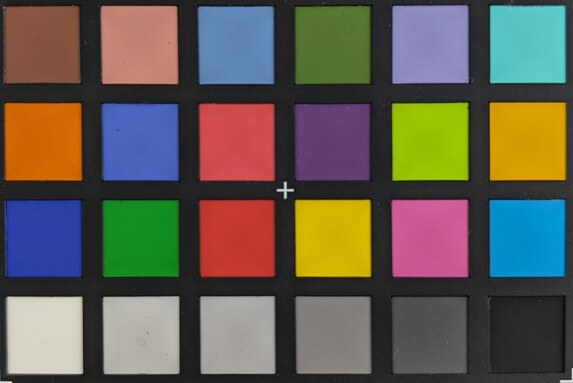
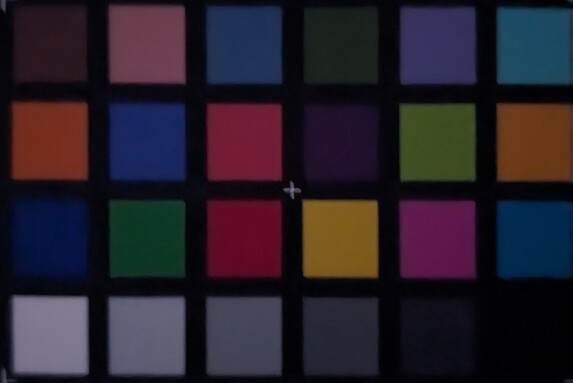
Accessories and Warranty - A slim box for the Pixel 8 Pro
The Google Pixel 8 Pro is delivered without a charger again, and the rest of the box contents remain unchanged: In addition to a USB-C cable, the box contains an OTG adapter (USB-C to USB-A) and a SIM tool. Optionally, you can also get a 30-Watt charger for 29 Euros (~$31) and a Gen. 2 Pixel Stand for 79 Euros (~$84).
Google offers a 24-month warranty for its smartphone.
Input Devices and Operation - Pixel smartphone with IR thermometer
You can give inputs to the Pixel 8 Pro via the capacitive touchscreen, which implements them quickly and accurately and offers very good sliding characteristics. The two physical keys sit tightly in the frame and offer a short and crisp stroke.
Next to the camera setup in the back is an infrared sensor that can be used to measure surface temperatures. Google explicitly mentions that this is not a thermometer to measure body temperature. To get results that are as accurate as possible, you should choose the surface material carefully. Once you do that, the results are at a similar level as those of our Voltcraft IR-260, showing temperatures that are only between 0.5 and 1.5 °C (0.9 - 2.7 °F) lower.
An optical fingerprint sensor in the display provides biometric security. The recognition rates are decent most of the time, and it unlocks the smartphone fairly quickly. In addition, you can also use 2D face recognition, which works faster but isn't as secure.
The linear vibration motor provides powerful and attractive haptic feedback.
Display - Google reduces the resolution
Google has reduced the display resolution of the Pixel 8 Pro compared to the predecessor. However, this will hardly be noticeable considering a pixel density of 490 PPI. The LTPO-OLED panel is now significantly brighter. Google speaks about up to 1,600 cd/m² (HDR) and 2,400 cd/m² (top brightness). The refresh rate is automatically adjusted between 1 and 120 Hz by the system.
In the measurements, our test unit achieves a maximum brightness of 1,510 cd/m² with pure white display contents and activated brightness sensor. With an even distribution of bright and dark areas (APL18), it reaches up to 2,202 cd/m² and in the HDR reproduction, even 2,363 cd/m². If you only adjust the brightness manually, you can get up to 985 cd/m².
Unfortunately, the OLED flickering of the display doesn't have a very high frequency. Using an oscilloscope, we measure a constant 120 Hz with a stable amplitude at minimal display brightness. Above a level of 43% brightness, the frequency doubles to 240 Hz. Those who are sensitive to the flickering of displays can expect some problems here.
| |||||||||||||||||||||||||
Brightness Distribution: 92 %
Center on Battery: 1510 cd/m²
Contrast: ∞:1 (Black: 0 cd/m²)
ΔE Color 1.1 | 0.5-29.43 Ø5.1
ΔE Greyscale 1.7 | 0.57-98 Ø5.3
99.5% sRGB (Calman 2D)
Gamma: 2.23
| Google Pixel 8 Pro OLED, 2992x1344, 6.70 | Xiaomi 13T Pro AMOLED, 2712x1220, 6.67 | Apple iPhone 15 Pro Max OLED, 2796x1290, 6.70 | Samsung Galaxy S23 Ultra Dynamic AMOLED 2x, 3080x1440, 6.80 | Honor Magic5 Pro OLED, 2848x1312, 6.81 | Google Pixel 7 Pro OLED, 3120x1440, 6.70 | |
|---|---|---|---|---|---|---|
| Screen | -12% | -4% | -30% | -28% | 7% | |
| Brightness middle | 1510 | 1252 -17% | 1102 -27% | 1117 -26% | 1291 -15% | 1022 -32% |
| Brightness | 1467 | 1230 -16% | 1102 -25% | 1133 -23% | 1289 -12% | 1025 -30% |
| Brightness Distribution | 92 | 96 4% | 98 7% | 97 5% | 96 4% | 99 8% |
| Black Level * | ||||||
| Colorchecker dE 2000 * | 1.1 | 1.4 -27% | 1.1 -0% | 2.2 -100% | 1.7 -55% | 0.9 18% |
| Colorchecker dE 2000 max. * | 3.8 | 3.1 18% | 3.1 18% | 3.9 -3% | 4.4 -16% | 2.1 45% |
| Greyscale dE 2000 * | 1.7 | 2.3 -35% | 1.6 6% | 2.3 -35% | 2.9 -71% | 1.1 35% |
| Gamma | 2.23 99% | 2.23 99% | 2.19 100% | 2.37 93% | 2.28 96% | 2.22 99% |
| CCT | 6670 97% | 6590 99% | 6555 99% | 6572 99% | 6472 100% | 6650 98% |
* ... smaller is better
Screen Flickering / PWM (Pulse-Width Modulation)
| Screen flickering / PWM detected | 120 Hz | ||
The display backlight flickers at 120 Hz (Likely utilizing PWM) . The frequency of 120 Hz is very low, so the flickering may cause eyestrain and headaches after extended use. In comparison: 53 % of all tested devices do not use PWM to dim the display. If PWM was detected, an average of 18716 (minimum: 5 - maximum: 3846000) Hz was measured. | |||
Measurement series at fixed zoom level with various brightness settings
The color reproduction is convincing in the Calman analysis. In the grayscale, only the two brightest white tones show a very slight green tint, and in the colors, there are no noticeable color differences that can be discerned without a measurement device.
Display Response Times
| ↔ Response Time Black to White | ||
|---|---|---|
| 1.07 ms ... rise ↗ and fall ↘ combined | ↗ 0.568 ms rise | |
| ↘ 0.504 ms fall | ||
| The screen shows very fast response rates in our tests and should be very well suited for fast-paced gaming. In comparison, all tested devices range from 0.1 (minimum) to 240 (maximum) ms. » 1 % of all devices are better. This means that the measured response time is better than the average of all tested devices (21.8 ms). | ||
| ↔ Response Time 50% Grey to 80% Grey | ||
| 1.85 ms ... rise ↗ and fall ↘ combined | ↗ 1.024 ms rise | |
| ↘ 0.822 ms fall | ||
| The screen shows very fast response rates in our tests and should be very well suited for fast-paced gaming. In comparison, all tested devices range from 0.2 (minimum) to 636 (maximum) ms. » 4 % of all devices are better. This means that the measured response time is better than the average of all tested devices (34.3 ms). | ||
Performance - The Tensor G3 limps behind the competitors
The Pixel 8 Pro uses the inhouse Google Tensor G3 SoC, which is accompanied by 12 GB of working memory. The chipset is able to use a total of up to nine CPU cores, one of which is a Cortex X3 representing the most powerful unit with a clock speed of up to 2.91 GHz. The SoC is manufactured by Samsung in the 4-nm process.
In terms of CPU performance, the Tensor G3 is unable to keep up with the Apple A17 Pro, the Dimensity 9200+, or the Snapdragon 8 Gen 2, clearly coming in last in the high-end area. Only in the current Geekbench 6.2, the Pixel 8 Pro places ahead of the Xiaomi 13T Pro with the MediaTek chipset.
Even if Android runs smoothly in everyday operation, the Pixel 8 Pro doesn't do particularly well in the system benchmarks, where it also only places last in our comparison field. In summary, at this point the Tensor G3 performs more at the level of a modern high-class SoC such as the Snapdragon 7+ Gen 2.
And if you think that the Pixel 8 Pro will finally catch up in the AI benchmarks, you will also be disappointed. In Procyon, it is even slower than its predecessor, and in AIMark and Geekbench ML, it is only minimally faster.
| Geekbench 5.5 | |
| Single-Core | |
| Samsung Galaxy S23 | |
| Xiaomi 13T Pro | |
| Honor Magic5 Pro | |
| Google Pixel 8 Pro | |
| Average Google Tensor G3 (1260 - 1274, n=2) | |
| Xiaomi Poco F5 | |
| Google Pixel 7 Pro | |
| Average of class Smartphone (119 - 2138, n=223, last 2 years) | |
| Multi-Core | |
| Samsung Galaxy S23 | |
| Honor Magic5 Pro | |
| Xiaomi 13T Pro | |
| Xiaomi Poco F5 | |
| Google Pixel 8 Pro | |
| Average Google Tensor G3 (3395 - 3624, n=2) | |
| Google Pixel 7 Pro | |
| Average of class Smartphone (473 - 5538, n=223, last 2 years) | |
| Geekbench 6.2 | |
| Single-Core | |
| Apple iPhone 15 Pro Max | |
| Honor Magic5 Pro | |
| Samsung Galaxy S23 | |
| Google Pixel 8 Pro | |
| Average Google Tensor G3 (1653 - 1769, n=2) | |
| Xiaomi Poco F5 | |
| Xiaomi 13T Pro | |
| Google Pixel 7 Pro | |
| Average of class Smartphone (193 - 2930, n=58, last 2 years) | |
| Multi-Core | |
| Apple iPhone 15 Pro Max | |
| Samsung Galaxy S23 | |
| Honor Magic5 Pro | |
| Google Pixel 8 Pro | |
| Average Google Tensor G3 (4225 - 4538, n=2) | |
| Xiaomi Poco F5 | |
| Google Pixel 7 Pro | |
| Xiaomi 13T Pro | |
| Average of class Smartphone (845 - 7244, n=58, last 2 years) | |
| Antutu v9 - Total Score | |
| Xiaomi 13T Pro | |
| Honor Magic5 Pro | |
| Samsung Galaxy S23 | |
| Xiaomi Poco F5 | |
| Google Pixel 8 Pro | |
| Google Pixel 7 Pro | |
| Average Google Tensor G3 (603046 - 896410, n=2) | |
| Average of class Smartphone (102602 - 1478071, n=158, last 2 years) | |
| Antutu v10 - Total Score | |
| Samsung Galaxy S23 | |
| Apple iPhone 15 Pro Max | |
| Honor Magic5 Pro | |
| Average of class Smartphone (461567 - 1562239, n=14, last 2 years) | |
| Google Pixel 8 Pro | |
| Average Google Tensor G3 (1107295 - 1113506, n=2) | |
| PCMark for Android - Work 3.0 | |
| Honor Magic5 Pro | |
| Samsung Galaxy S23 | |
| Xiaomi Poco F5 | |
| Xiaomi 13T Pro | |
| Google Pixel 8 Pro | |
| Google Pixel 7 Pro | |
| Average Google Tensor G3 (10897 - 11824, n=2) | |
| Average of class Smartphone (4761 - 19783, n=215, last 2 years) | |
| CrossMark - Overall | |
| Apple iPhone 15 Pro Max | |
| Samsung Galaxy S23 | |
| Honor Magic5 Pro | |
| Average Google Tensor G3 (935 - 955, n=2) | |
| Xiaomi 13T Pro | |
| Google Pixel 8 Pro | |
| Google Pixel 7 Pro | |
| Xiaomi Poco F5 | |
| Average of class Smartphone (200 - 1408, n=156, last 2 years) | |
| UL Procyon AI Inference - Overall Score | |
| Xiaomi 13T Pro | |
| Google Pixel 7 Pro | |
| Google Pixel 8 Pro | |
| Average Google Tensor G3 (25563 - 27018, n=2) | |
| Average of class Smartphone (207 - 84787, n=127, last 2 years) | |
| Samsung Galaxy S23 | |
| Honor Magic5 Pro | |
| Xiaomi Poco F5 | |
| AImark - Score v3.x | |
| Apple iPhone 15 Pro Max | |
| Average of class Smartphone (298 - 128240, n=77, last 2 years) | |
| Samsung Galaxy S23 | |
| Honor Magic5 Pro | |
| Xiaomi Poco F5 | |
| Average Google Tensor G3 (1109 - 1136, n=2) | |
| Google Pixel 8 Pro | |
| Google Pixel 7 Pro | |
| Xiaomi 13T Pro | |
| Geekbench ML | |
| TensorFlow Lite CPU 0.5 | |
| Apple iPhone 15 Pro Max | |
| Samsung Galaxy S23 | |
| Honor Magic5 Pro | |
| Average of class Smartphone (215 - 1418, n=20, last 2 years) | |
| Google Pixel 8 Pro | |
| Average Google Tensor G3 | |
| Google Pixel 7 Pro | |
| TensorFlow Lite GPU 0.5 | |
| Apple iPhone 15 Pro Max | |
| Samsung Galaxy S23 | |
| Honor Magic5 Pro | |
| Average of class Smartphone (474 - 2842, n=20, last 2 years) | |
| Google Pixel 8 Pro | |
| Average Google Tensor G3 | |
| Google Pixel 7 Pro | |
| TensorFlow Lite NNAPI / Core ML 0.5 | |
| Apple iPhone 15 Pro Max | |
| Google Pixel 7 Pro | |
| Google Pixel 8 Pro | |
| Average Google Tensor G3 | |
| Average of class Smartphone (377 - 3638, n=18, last 2 years) | |
| Samsung Galaxy S23 | |
| Honor Magic5 Pro | |
The Google Pixel 8 Pro uses an integrated ARM Mali-G715 MP7 as graphics unit. Even though this is faster than the G710 MP7 in the Pixel 7 Pro, it is slower than the competitors in all areas.
Since Google doesn't use the Immortalis version of the G715 here, raytracing is also not supported.
GFXBench (DX / GLBenchmark) 2.7: T-Rex Onscreen | 1920x1080 T-Rex Offscreen
GFXBench 3.0: on screen Manhattan Onscreen OGL | 1920x1080 1080p Manhattan Offscreen
GFXBench 3.1: on screen Manhattan ES 3.1 Onscreen | 1920x1080 Manhattan ES 3.1 Offscreen
GFXBench: on screen Car Chase Onscreen | 1920x1080 Car Chase Offscreen | on screen Aztec Ruins High Tier Onscreen | 2560x1440 Aztec Ruins High Tier Offscreen | on screen Aztec Ruins Normal Tier Onscreen | 1920x1080 Aztec Ruins Normal Tier Offscreen | 3840x2160 4K Aztec Ruins High Tier Offscreen
| 3DMark / Wild Life Extreme Unlimited | |
| Apple iPhone 15 Pro Max | |
| Samsung Galaxy S23 | |
| Honor Magic5 Pro | |
| Xiaomi 13T Pro | |
| Google Pixel 8 Pro | |
| Google Pixel 7 Pro | |
| 3DMark / Wild Life Extreme | |
| Samsung Galaxy S23 | |
| Apple iPhone 15 Pro Max | |
| Honor Magic5 Pro | |
| Xiaomi 13T Pro | |
| Google Pixel 8 Pro | |
| Google Pixel 7 Pro | |
| 3DMark / Wild Life Unlimited Score | |
| Apple iPhone 15 Pro Max | |
| Samsung Galaxy S23 | |
| Honor Magic5 Pro | |
| Xiaomi 13T Pro | |
| Google Pixel 8 Pro | |
| Google Pixel 7 Pro | |
| 3DMark / Wild Life Score | |
| Google Pixel 8 Pro | |
| Google Pixel 7 Pro | |
| Honor Magic5 Pro | |
| 3DMark / Sling Shot Extreme (ES 3.1) Unlimited Physics | |
| Honor Magic5 Pro | |
| Samsung Galaxy S23 | |
| Google Pixel 8 Pro | |
| Google Pixel 7 Pro | |
| Xiaomi 13T Pro | |
| 3DMark / Sling Shot Extreme (ES 3.1) Unlimited Graphics | |
| Honor Magic5 Pro | |
| Samsung Galaxy S23 | |
| Xiaomi 13T Pro | |
| Google Pixel 8 Pro | |
| Google Pixel 7 Pro | |
| 3DMark / Sling Shot Extreme (ES 3.1) Unlimited | |
| Honor Magic5 Pro | |
| Samsung Galaxy S23 | |
| Xiaomi 13T Pro | |
| Google Pixel 8 Pro | |
| Google Pixel 7 Pro | |
| GFXBench (DX / GLBenchmark) 2.7 / T-Rex Onscreen | |
| Google Pixel 7 Pro | |
| Samsung Galaxy S23 | |
| Xiaomi 13T Pro | |
| Google Pixel 8 Pro | |
| Honor Magic5 Pro | |
| Apple iPhone 15 Pro Max | |
| GFXBench (DX / GLBenchmark) 2.7 / T-Rex Offscreen | |
| Xiaomi 13T Pro | |
| Honor Magic5 Pro | |
| Samsung Galaxy S23 | |
| Apple iPhone 15 Pro Max | |
| Google Pixel 8 Pro | |
| Google Pixel 7 Pro | |
| GFXBench 3.0 / Manhattan Onscreen OGL | |
| Samsung Galaxy S23 | |
| Xiaomi 13T Pro | |
| Google Pixel 8 Pro | |
| Google Pixel 7 Pro | |
| Honor Magic5 Pro | |
| Apple iPhone 15 Pro Max | |
| GFXBench 3.0 / 1080p Manhattan Offscreen | |
| Xiaomi 13T Pro | |
| Samsung Galaxy S23 | |
| Apple iPhone 15 Pro Max | |
| Honor Magic5 Pro | |
| Google Pixel 8 Pro | |
| Google Pixel 7 Pro | |
| GFXBench 3.1 / Manhattan ES 3.1 Onscreen | |
| Samsung Galaxy S23 | |
| Xiaomi 13T Pro | |
| Google Pixel 8 Pro | |
| Honor Magic5 Pro | |
| Apple iPhone 15 Pro Max | |
| Google Pixel 7 Pro | |
| GFXBench 3.1 / Manhattan ES 3.1 Offscreen | |
| Honor Magic5 Pro | |
| Xiaomi 13T Pro | |
| Samsung Galaxy S23 | |
| Apple iPhone 15 Pro Max | |
| Google Pixel 8 Pro | |
| Google Pixel 7 Pro | |
| GFXBench / Car Chase Onscreen | |
| Samsung Galaxy S23 | |
| Xiaomi 13T Pro | |
| Google Pixel 8 Pro | |
| Honor Magic5 Pro | |
| Apple iPhone 15 Pro Max | |
| Google Pixel 7 Pro | |
| GFXBench / Car Chase Offscreen | |
| Honor Magic5 Pro | |
| Samsung Galaxy S23 | |
| Apple iPhone 15 Pro Max | |
| Xiaomi 13T Pro | |
| Google Pixel 8 Pro | |
| Google Pixel 7 Pro | |
| GFXBench / Aztec Ruins High Tier Onscreen | |
| Samsung Galaxy S23 | |
| Xiaomi 13T Pro | |
| Google Pixel 8 Pro | |
| Honor Magic5 Pro | |
| Apple iPhone 15 Pro Max | |
| Google Pixel 7 Pro | |
| GFXBench / Aztec Ruins High Tier Offscreen | |
| Honor Magic5 Pro | |
| Samsung Galaxy S23 | |
| Apple iPhone 15 Pro Max | |
| Xiaomi 13T Pro | |
| Google Pixel 8 Pro | |
| Google Pixel 7 Pro | |
| GFXBench / Aztec Ruins Normal Tier Onscreen | |
| Samsung Galaxy S23 | |
| Google Pixel 8 Pro | |
| Xiaomi 13T Pro | |
| Honor Magic5 Pro | |
| Apple iPhone 15 Pro Max | |
| Google Pixel 7 Pro | |
| GFXBench / Aztec Ruins Normal Tier Offscreen | |
| Samsung Galaxy S23 | |
| Xiaomi 13T Pro | |
| Honor Magic5 Pro | |
| Apple iPhone 15 Pro Max | |
| Google Pixel 8 Pro | |
| Google Pixel 7 Pro | |
| GFXBench / 4K Aztec Ruins High Tier Offscreen | |
| Samsung Galaxy S23 | |
| Honor Magic5 Pro | |
| Xiaomi 13T Pro | |
| Apple iPhone 15 Pro Max | |
| Google Pixel 8 Pro | |
| Google Pixel 7 Pro | |
Basemark GPUScore
Since the Pixel 8 Pro offers the lowest computing power in our comparison field, it is also not surprising that it doesn't place in one of the top positions. However, it is still sufficient to secure a place in the middle of the field in the benchmarks. Subjectively, surfing the web feels fast and works without any delays worth mentioning.
| Jetstream 2 - Total Score | |
| Apple iPhone 15 Pro Max (Safari Mobile 17) | |
| Samsung Galaxy S23 Ultra (Chrome 109) | |
| Xiaomi 13T Pro (Chrome 117) | |
| Honor Magic5 Pro (Chrome 111) | |
| Google Pixel 8 Pro (Chrome 117) | |
| Average Google Tensor G3 (104.3 - 105.2, n=2) | |
| Google Pixel 7 Pro (Chrome 106) | |
| Average of class Smartphone (21.2 - 351, n=166, last 2 years) | |
| Speedometer 2.0 - Result | |
| Apple iPhone 15 Pro Max (Safari Mobile 17) | |
| Xiaomi 13T Pro (Chrome 117) | |
| Google Pixel 8 Pro (Chrome 117) | |
| Average Google Tensor G3 (136 - 158, n=2) | |
| Samsung Galaxy S23 Ultra (Chrome 109) | |
| Honor Magic5 Pro (Chrome 111) | |
| Google Pixel 7 Pro (Chrome 106) | |
| Average of class Smartphone (14.9 - 445, n=154, last 2 years) | |
| WebXPRT 4 - Overall Score | |
| Samsung Galaxy S23 Ultra (Chrome 110) | |
| Google Pixel 8 Pro (Chrome 117) | |
| Average Google Tensor G3 (94 - 103, n=2) | |
| Honor Magic5 Pro (Chrome 111) | |
| Xiaomi 13T Pro (Chrome 117) | |
| Average of class Smartphone (25 - 202, n=123, last 2 years) | |
| Google Pixel 7 Pro (Chrome 106) | |
| WebXPRT 3 - --- | |
| Apple iPhone 15 Pro Max (Safari Mobile 17) | |
| Xiaomi 13T Pro (Chrome 117) | |
| Google Pixel 8 Pro (Chrome 117) | |
| Average of class Smartphone (37 - 304, n=131, last 2 years) | |
| Average Google Tensor G3 (115 - 129, n=2) | |
| Google Pixel 7 Pro (Chrome 106) | |
| Octane V2 - Total Score | |
| Apple iPhone 15 Pro Max (Safari Mobile 17) | |
| Samsung Galaxy S23 Ultra (Chrome 109) | |
| Google Pixel 8 Pro (Chrome 117) | |
| Average Google Tensor G3 (47776 - 49506, n=2) | |
| Google Pixel 7 Pro (Chrome 106) | |
| Honor Magic5 Pro (Chrome 111) | |
| Xiaomi 13T Pro (Chrome 117) | |
| Average of class Smartphone (4633 - 89112, n=198, last 2 years) | |
| Mozilla Kraken 1.1 - Total Score | |
| Average of class Smartphone (388 - 9999, n=164, last 2 years) | |
| Xiaomi 13T Pro (Chrome 117) | |
| Google Pixel 7 Pro (Chrome 106) | |
| Honor Magic5 Pro (Chrome 111) | |
| Average Google Tensor G3 (840 - 998, n=2) | |
| Google Pixel 8 Pro (Chrome 117) | |
| Samsung Galaxy S23 Ultra (Chrome 109) | |
| Apple iPhone 15 Pro Max (Safari Mobile 17) | |
* ... smaller is better
Games - More than just casual games
Even though the ARM Mali-G715 MP7 in the Pixel 8 Pro doesn't support raytracing, it offers sufficient power for all the games in the Play Store at the time of this test. Unfortunately, we are still unable to show any gaming benchmarks at this point, since GameBench still hasn't been optimized for Android 14. We will add those as soon as possible.
Even demanding games can be played in full detail settings without running into any noticeable problems. Only in Genshin Impact do we notice some small stutters from time to time.
Emissions - Dual-speakers in the Pixel 8 Pro
Temperatures
The surface temperatures of the Google Pixel 8 Pro increase noticeably under load. We simulate this with the Burnout benchmark, reaching temperatures of almost 44 °C (111 °F) in some spots. However, this won't be a problem in everyday operation.
In the stress test with 3DMark, the cooling of the Tensor G3 is unable to keep the SoC stable, but it is only throttled moderately by between 12 and 14%. Even if a Snapdragon 8 Gen 2 for Galaxy in the S23 Ultra is throttled significantly more, losing more of its performance, it still remains faster.
(±) The maximum temperature on the upper side is 43 °C / 109 F, compared to the average of 35 °C / 95 F, ranging from 21.9 to 56 °C for the class Smartphone.
(±) The bottom heats up to a maximum of 43.8 °C / 111 F, compared to the average of 33.8 °C / 93 F
(+) In idle usage, the average temperature for the upper side is 27 °C / 81 F, compared to the device average of 32.7 °C / 91 F.
3DMark Wild Life Stress Test
| 3DMark | |
| Wild Life Stress Test Stability | |
| Apple iPhone 15 Pro Max | |
| Google Pixel 8 Pro | |
| Xiaomi 13T Pro | |
| Samsung Galaxy S23 Ultra | |
| Google Pixel 7 Pro | |
| Honor Magic5 Pro | |
| Wild Life Extreme Stress Test | |
| Xiaomi 13T Pro | |
| Google Pixel 8 Pro | |
| Google Pixel 7 Pro | |
| Apple iPhone 15 Pro Max | |
| Samsung Galaxy S23 Ultra | |
| Honor Magic5 Pro | |
| Solar Bay Stress Test Stability | |
| Xiaomi 13T Pro | |
| Honor Magic5 Pro | |
| Apple iPhone 15 Pro Max | |
Speakers
The two speakers of the Google Pixel 8 Pro produce a fairly wide sound image, even if the super high frequencies drop a bit sharply and the low frequencies are only weak. Although the sound is slightly dull overall, it is still one of the better sounds in the smartphone area.
For external sound output, you can either use the USB port for wired output, or alternatively Bluetooth 5.3 is also available. The later offers a wide codec support, but some of the newer codecs from Qualcomm such as aptX Adaptive and TWS+ are missing.
Google Pixel 8 Pro audio analysis
(+) | speakers can play relatively loud (89.4 dB)
Bass 100 - 315 Hz
(-) | nearly no bass - on average 18.4% lower than median
(±) | linearity of bass is average (9.1% delta to prev. frequency)
Mids 400 - 2000 Hz
(±) | reduced mids - on average 5.2% lower than median
(+) | mids are linear (4.8% delta to prev. frequency)
Highs 2 - 16 kHz
(±) | higher highs - on average 6.4% higher than median
(+) | highs are linear (4.6% delta to prev. frequency)
Overall 100 - 16.000 Hz
(±) | linearity of overall sound is average (15.7% difference to median)
Compared to same class
» 2% of all tested devices in this class were better, 3% similar, 95% worse
» The best had a delta of 12%, average was 39%, worst was 134%
Compared to all devices tested
» 19% of all tested devices were better, 4% similar, 77% worse
» The best had a delta of 4%, average was 26%, worst was 134%
Samsung Galaxy S23 Ultra audio analysis
(+) | speakers can play relatively loud (91.8 dB)
Bass 100 - 315 Hz
(-) | nearly no bass - on average 19.4% lower than median
(+) | bass is linear (5.1% delta to prev. frequency)
Mids 400 - 2000 Hz
(±) | reduced mids - on average 5.1% lower than median
(+) | mids are linear (4.2% delta to prev. frequency)
Highs 2 - 16 kHz
(±) | higher highs - on average 6.2% higher than median
(+) | highs are linear (2.5% delta to prev. frequency)
Overall 100 - 16.000 Hz
(±) | linearity of overall sound is average (15.6% difference to median)
Compared to same class
» 2% of all tested devices in this class were better, 2% similar, 95% worse
» The best had a delta of 12%, average was 39%, worst was 134%
Compared to all devices tested
» 18% of all tested devices were better, 4% similar, 78% worse
» The best had a delta of 4%, average was 26%, worst was 134%
Battery Life - 5,050 mAh for the Google smartphone
Power Consumption
Compared to the predecessor, the power consumption of the Google Pixel 8 Pro has improved and is at an inconspicuous level. The higher consumption values we measure under load can be traced back to the Burnout benchmark that we now use, which is significantly more demanding than our earlier stability test.
The Pixel 8 Pro supports wired quick charging at up to 30 watts (PD 3.0). Using the corresponding charger, it is supposed to be recharged back up to 50% within 30 minutes. If you use a Pixel Stand (Gen. 2), you can use wireless charging at up to 23 watts, while regular Qi chargers are supported up to 12 watts. In the test, it took 101 minutes to recharge the smartphone using an Anker Ace 313 (45 Watt) charger.
| Off / Standby | |
| Idle | |
| Load |
|
| Google Pixel 8 Pro 5050 mAh | Xiaomi 13T Pro 5000 mAh | Apple iPhone 15 Pro Max 4422 mAh | Samsung Galaxy S23 Ultra 5000 mAh | Honor Magic5 Pro 5100 mAh | Google Pixel 7 Pro 5000 mAh | Average Google Tensor G3 | Average of class Smartphone | |
|---|---|---|---|---|---|---|---|---|
| Power Consumption | -25% | -0% | 15% | 11% | 10% | 6% | 1% | |
| Idle Minimum * | 0.63 | 0.99 -57% | 0.5 21% | 0.9 -43% | 0.91 -44% | 0.78 -24% | 0.595 ? 6% | 0.893 ? -42% |
| Idle Average * | 1.47 | 1.14 22% | 1.97 -34% | 1.05 29% | 1.63 -11% | 1.61 -10% | 1.275 ? 13% | 1.469 ? -0% |
| Idle Maximum * | 1.55 | 1.34 14% | 1.99 -28% | 1.1 29% | 1.67 -8% | 1.63 -5% | 1.36 ? 12% | 1.673 ? -8% |
| Load Average * | 8.45 | 10.06 -19% | 3.36 60% | 3.99 53% | 2.61 69% | 3.29 61% | 8.23 ? 3% | 4.83 ? 43% |
| Load Maximum * | 8.63 | 15.94 -85% | 10.43 -21% | 7.82 9% | 4.57 47% | 6.01 30% | 8.76 ? -2% | 7.7 ? 11% |
* ... smaller is better
Power Consumption: Geekbench (150 cd/m²)
Power Consumption: GFXBench (150 cd/m²)
Battery Life
With 5,050 mAh, the Google Pixel 8 Pro has a slightly larger battery than its predecessor. It delivers good runtimes in the test, some of which are better and others worse than those of the Pixel 7 Pro. But it is still surprising that they are significantly shorter than those of the competitors.
The best way to compare the runtimes are tests at an adjusted display brightness (150 cd/m²). Even though the Pixel 8 Pro lasts almost 1.5 hours longer in the WLAN test than the 7 Pro, the competitors last between 41 and 53% longer.
| Google Pixel 8 Pro 5050 mAh | Xiaomi 13T Pro 5000 mAh | Apple iPhone 15 Pro Max 4422 mAh | Samsung Galaxy S23 Ultra 5000 mAh | Honor Magic5 Pro 5100 mAh | Google Pixel 7 Pro 5000 mAh | |
|---|---|---|---|---|---|---|
| Battery Runtime | 47% | 92% | 56% | 42% | -3% | |
| Reader / Idle | 1344 | 1798 34% | 3514 161% | 2139 59% | 2580 92% | 1210 -10% |
| H.264 | 1122 | 1298 16% | 2013 79% | 1543 38% | 1249 11% | 1213 8% |
| WiFi v1.3 | 760 | 1099 45% | 1163 53% | 1100 45% | 1074 41% | 676 -11% |
| Load | 220 | 427 94% | 384 75% | 400 82% | 276 25% | 226 3% |
Pros
Cons
Verdict - A well-rounded overall package with a great camera
The Google Pixel 8 Pro is a very good smartphone with pure Android, which impresses with a well-rounded overall concept and elegant design. The Pixel convinces with a very bright and accurate display, a good system performance, and a great camera setup. With seven years of updates, it is the smartphone with the longest update guarantee at the time of the test. At this point, even Apple and Samsung are unable to keep up with this. Only the Fairphone 5 offers a longer update period, at least of the security patches.
The Google Pixel 8 Pro impresses with a long update period and great cameras, but it could offer a more powerful performance for a high-end smartphone.
Of course, potentially being able to use the phone for more years will also have an effect on the price. But the price increase turns out quite hefty, so that the Pixel 8 Pro loses its "great deal" character, particularly since the entry-level version offers relatively little storage with only 128 GB. The storage is also significantly slower than that of the competitors, all of which already offer the more modern UFS 4.0 storage. In terms of the SoC, Google also doesn't really offer anything very powerful here, and the highly praised Google AI only runs in the Google Cloud.
But those who are simply looking for an everyday companion that will potentially last for a long time while always remaining current with the software will get just the right thing with the Google smartphone – including good pictures. Those who are looking for more computing power while being tied less to the cloud and still get a longer battery life might find a powerful alternative in the Galaxy S23 Ultra. And those who are also open to the Apple universe should take a look at the iPhone 15 Pro Max.
Price and Availability
The Pixel 8 Pro is available in all color and storage versions directly from Google starting from $999. Alternatively, you can also get it from Amazon, for example.
Google Pixel 8 Pro
-
11/07/2023 v7
Daniel Schmidt
Transparency
The present review sample was given to the author by the manufacturer free of charge for the purposes of review. There was no third-party influence on this review, nor did the manufacturer receive a copy of this review before publication. There was no obligation to publish this review.


 Deutsch
Deutsch English
English Español
Español Français
Français Italiano
Italiano Nederlands
Nederlands Polski
Polski Português
Português Русский
Русский Türkçe
Türkçe Svenska
Svenska Chinese
Chinese Magyar
Magyar